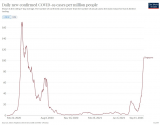You presented two alternatives:
- vaccinated with 0.026% chance of myocarditis . WITHOUT infected.
- un-vaccinated and infected with 0.17% chance of myocarditis.
But I see many more possibilities. Here is my further breakdown of the two, and the ultimate chance of getting myocarditis at the end of them.
- vaccinated
- NOT infected by COVID. 0.026%
- Infected by COVID due to breakthrough infection. This chance is pretty high right now. What is the chance of still getting myocarditis? Let's say it is A% The breakthrough chance is B%. So the final chance is 0.026% + B%*A%
- un-vaccinated
- Without precautionary measures. X% chance to get infected by COVID that leads to 0.17% chance of myocarditis. X%*0.17%
- With precautionary measures (no party, no travel, face mask etc.). Y% chance to get infected by COVID to begin with. Y%*0.17%
- Zero case policy by the state. Z% chance for me to get infected. Z%*0.17%
In my opinion, Z% could be the lowest, almost down to zero. For me it is the best choice.
Of course I live in Europe, so 2.3 is not an option. 2.2 may be better than 1.1 in the final chance of sickness.
You sound very much like what the health authority in Europe was saying at the time when AZ was shunned that "the benefit of AZ outweighs its risk". This line of argument does NOT take into consideration of perceived efficacy of individual's social behavior and personal measures. But people make their choice with this consideration in mind. That is why the government wasn't convincing people and failed. You can see the failure that so many AZ vaccines being expired and wasted together with money.
Let me share my own experience and possible choice. I am a person against the "anti-vaccination" group and conspiracy theory. But I don't blindly buy the BS from incompetent politicians or the money thirsty enterprises.
I have taken two does of BioNtech. At the time of vaccination, I have determined that if I was offered AZ, I would turn that down and rely on my own precautionary measures because I am confident that these measures are adequate to reduce my chance of anything than the risk of AZ. That decision was also based on the efficacy of BioNtech at the time against pre-Delta variants.
Now with the much lower efficacy of BioNtech against Delta, the risk of side effect (in my personal calculation) is exceeding the risk of getting infected by COVID by my own precautionary measures.
Now there is an ongoing round of booster shot of BioNtech where I live. I am not offered because I am not in the risk group. But even if the general public is offered some months later, I will take decision based on new data of the efficacy on the new variant prevalent at the time. I may or may not take the vaccine.

